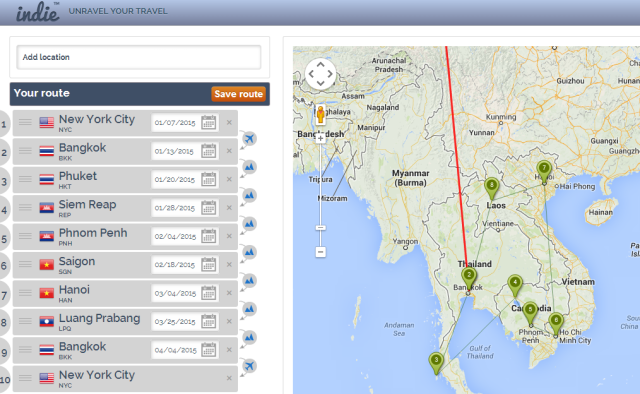You probably already know about the disadvantages of taking one huge trip instead of a series of shorter ones over the course of several years.
- You may have to quit your job and start again from scratch upon return.
- You’ll probably have to give up your apartment or house and put things in storage.
- You may miss out on several important events in the lives of your family and friends.
- You have to save up a good chunk of change to make it happen.
You already know all the things you’ll be giving up, but friends and family might not understand why you seem willing to make these sacrifices just to live out of your backpack for months or even years.
We think that long-term travel is not only a perfectly sane thing to do, but something that all humans would benefit from.
Let’s take a look at some practical reasons why:
1. Efficiency

Or to put it in business terms, Economies of Scale.
For much of the world, long-distance airfare is by far the most expensive part of any trip, so by doing a big trip all at once, you can spread those airfare costs out along the length of your trip. It’s much cheaper to fly to the other side of the world once to explore multiple countries than flying there multiple times over the course of several years (especially when costs of traveling in certain parts of the world are so cheap).
Let’s look at a practical example:
- Let’s say a round trip flight to Thailand from your city is $1200USD.
- You plan on staying for 10 days, and during that 10 days, you spend $50/day on other travel expenses.
Total trip cost: $1700, or $170/day.
Instead of just taking 10 days to travel in Thailand, let’s say you get a one-month sabbatical from your job and plan on spending 30 days there instead of 10.
Let’s do the math:
- Same $1200 flight
- Same $50/day expenses.
Total trip cost: $2700, or $90/day
The total trip costs $1000 more, sure, but when you break it down to per day costs, they are almost half of a 10 day trip!
Extend that same trip to 90 days by staying in SE Asia – maybe you go to Laos, Cambodia, and Vietnam as well and travel overland, keeping that same $50/day expense, which is easily doable in this region (in fact, usually the longer you stay in a place, the less you end up spending).
Total trip cost: $5700, or $63/day
There are lots of people who blow their wads each year on a big week-long vacation to places like the Caribbean or Europe, and when on a shorter trip like that, it’s not difficult to blow through $3000, $5000, even $10,000, especially under the guise of unwinding and relaxing. When you’re overworked and only get a week or two of vacation a year, it’s far easier to justify spending silly amounts of money on that one free week.
By spending your travel budget all at once instead of a bit each year, though, you get much more bang for the buck.
2. Economy & Serendipity
This is directly related to the point above, but by connecting close places together into one trip, you can do it cheaply, and you also get to see many interesting places in between – sometimes by accident – while en route.
Let’s say you are in Bangkok and you want to visit one of Thailand’s island or beach areas in the south. Instead of one 10-hour train ride you can break it into two 5-hour rides for about the same cost. You take the same train, but half way down you hop off in a small and cheap non-tourist town for a relaxing in-between day (and if you like it, you can stay two days, or a week, or a month!).
With the clock ticking loudly on your annual short holiday, you can’t afford to take chances like this, but as part of long-term travel, side-trips like this can make for unforgettable adventures and are actually a great way to avoid travel burnout at the same time.
3. A unique anthropological perspective

This is one you might not think of until you are nearly done with a trip like this, but being able to string together key destinations all on one trip will give you a fascinating look at the history of our civilization that you can’t get in any book, or even on multiple trips over the course of years.
Consider that our civilization started in and around modern day Iran, and then spread west and east from there. So you find yourself in London, which is an ancient city, particularly for North Americans and Australians. Then as you travel you make your way to Rome, which is far older than London. After Rome you hit Athens, which again is much older than Rome. After Athens you can go to Istanbul and Cairo, and it’s like you are going back in time.
Visited years apart these cities are all fascinating, but if done while retracing the paths of humanity all in a row, you get an amazing perspective, not only of those cities, but of younger cities you’ll visit elsewhere as well. Each city is loaded with museums that help tell this story, but many of the buildings and architectural styles you’ll see just walking around will help tell this story in its own way. Even if this doesn’t sound too exciting now, it might be something you’ll never forget after your trip is finally over.
What makes people want to go RTW?

There has been a lot written about this topic, and if you are reading this, you probably have your own answer to this question, so we’ll keep this short.
Everyone has their own reason – a feeling of “when else will I be able to do this?” or a desire to get “off the grid” for a while, explore the world in a slower way, or live like a local in a few places for extended periods of time.
There is a romantic notion that by circling the globe once you’ve “seen the world,” but you’ll quickly realize that you haven’t. The more people travel and see, the more they want to travel and see.
For some people, RTW trips are so appealing because they permanently make you a traveling badass, no matter where else you might have gone or not gone. It’s like running a full marathon or climbing Everest. Once you’ve done a proper RTW trip, you are a permanent member of an elite club.
There is a romantic notion that by circling the globe once you’ve “seen the world,” but you’ll quickly realize that you haven’t. The more people travel and see, the more they want to travel and see. It’s an interesting thing that happens. When we went on our RTW trip, we figured we’d be crossing off a lot of destinations and activities from our list.
But we soon realized that there were so many more places to see and experience, more that we ever imagined or knew about, and that list keeps growing and growing the more you get out there.
In fact, after you travel long and far enough, you may stop keeping a list (whether physical or mental) and instead think of all the possibilities for growth through travel. After a while, you stop caring about seeing that next famous site and instead start craving that next foreign culture or meeting that next amazing local family or connecting with that next traveler you click with.
The trip becomes an unforgettable experience that will have an impact for the rest of your life.
Short vacations and breaks from the norm are great, and we encourage you to get your travel fix however you can, but there is simply NO WAY a short trip can have the same impact as traveling long-term.
Do you agree with this premise, or do you think short term travel can impact people the same way a longer trip can? Comment below and share your thoughts.
Photo credits: Gustavo Frazao, Don Mammoser, Florin Stana, PEPPERSMINT
